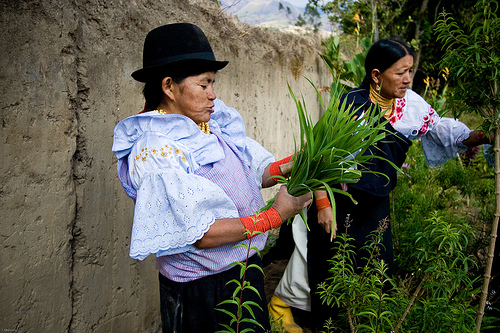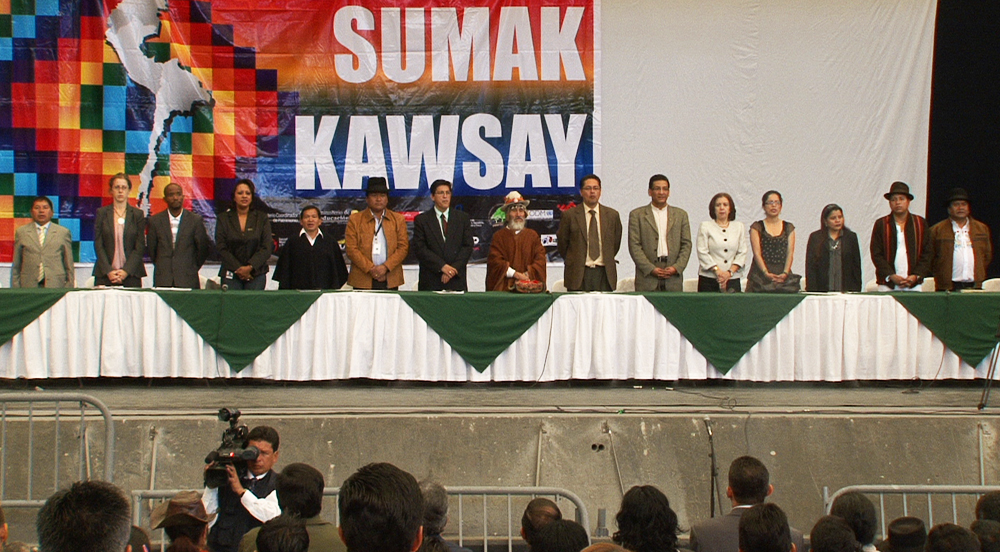2.2 Chapter Story
“LIVING A PLENTIFUL LIFE”: THE REACH OF SOCIAL CHANGE
For members of Indigenous Aymara and Quechua communities, time and events are experienced as cyclical and rhythmic: continuous, uncertain, and fluid. Everything that happens is connected, regardless of when the event occurs. This is a worldview that is common to Indigenous Peoples (Cross 1997). Pachakuti, introduced in Chapter 1, is an important expression of this Aymara and Quechua worldview. Pachakuti (along with other meanings) marks periods of time when social and environmental circumstances undergo major change.

Applied to current times, especially in the face of our environmental crisis, pachakuti reflects a call for the return of earth-based cultures that care for the earth and for the liberation of traditionally Indigenous lands (Arnez 2021). While the concept of pachakuti may be more limited to Aymara and Quechua communities, a related idea has been spreading into larger societies. Buen Vivir is a Spanish phrase that directly translates as “good living” or “living well.” The story of Buen Vivir and how it is growing as a globally recognized philosophy can tell us a lot about the reach of social change.
Buen Vivir
Buen Vivir interprets the Quechua and Aymara phrase sumak kawsay. Sumak kawsay is a call to envision an ideal and beautiful life: a life in harmony. It’s also an encouragement to apply our memories from the past to create meaning and hope for a dignified life in the present. These two ideas combined, it is a summons to live a “Plentiful Life” (Lechón 2017) (figure 2.1).
Crucial to this “Plentiful Life” is that our focus on well-being is not aimed at the individual. Instead, it promotes “collective well-being,” or care for our one great family (Arnez 2021). It calls for us to live a Plentiful Life in relation to our specific cultural-natural environment.
In order to live a Plentiful Life, Buen Vivir encourages a set of ethics that balances quality of life and democracy. Another idea crucial to a Plentiful Life is the rejection of segments of Western thinking that place humans as the most important entities on earth. Instead, Buen Vivir calls for humans to give inherent value to and have a reciprocal relationship with all living beings (Arnez 2021).
The concept of sumak kawsay has existed since before colonial times. However, as environmental degradation has advanced, it has moved into larger mainstream conversations in Latin America and beyond. Indigenous organizations have played a significant role in spreading the ideals of the Plentiful Life. These organizations included the Confederations of Indigenous Nationalities of Ecuador, Bolivia, and Peru, as well as larger coalitions of the Andean world, such as the Andean Coordinator of Indigenous Organizations (Hidalgo-Capitán and Cubillo-Guevara 2017).
The way of life that Buen Vivir upholds was incorporated into the constitutions of Ecuador (in 2008) and Bolivia (in 2009) (Zimmerer 2021). Ecuador’s new constitution outlined that the government will uphold sumak kawsay by:
- Guaranteeing Ecuadorians have a right to live in an ecologically balanced environment;
- Acknowledging the Amazon rainforest is important for ecological balance on Earth and providing it protection;
- Developing economic, political, sociocultural, and environmental systems that support sumak kawsay ideals;
- And promoting the use of scientific research, technological research, and ancestral wisdom to achieve sumak kawsay (Pachamama Alliance n.d.).
Bolivia’s constitutional changes drew from Buen Vivir for guiding actions of the state. They include ensuring dignity, social and gender equity, and social justice for everyone in Bolivian society. Bolivia’s 2011 Law of Mother Nature was the first legislation at the national level to bestow rights to the natural world (Mercado 2017; Rapid Transition Alliance 2018).

In 2011, in Quito, Ecuador, delegations from Bolivia, Colombia, Peru, and Chile joined their Ecuadoran hosts to attend the first gathering of Andean peoples focused on sumak kawsay (figure 2.2). Through keynotes and lectures, dances, and discussions, they shared principles and ambitions related to sumak kawsay.
Buen Vivir has become the way to communicate the ideas and ideals of sumak kawsay in Spanish, reaching a larger audience. Today, Buen Vivir influences academic and activist circles in North America, Europe, and Asia (Hernández and Laats 2020). In 2017, an international conference on Buen Vivir was held in Munich, Germany, to explore the question of “what is it that makes a good life?” The conference was supported by the European Commission (the governing body of the European Union), which promotes lifestyle choices and policies for positive effects on the environment and communities (Simpson 2017). Figure 2.3 shows a silent parade during the Buen Vivir conference in Munich.

Social Change and Buen Vivir
How did the concept of Buen Vivir spread so rapidly and become part of an international consciousness? Why is it becoming increasingly important to people? Applying sociology to those questions, we can point to a mix of social interactions at the global level between nations or at the regional level, such as in ecological zones. We can also examine interactions at the community level among villages and cities, and at the smaller group level, such as between members of government or within families.
The concept of Buen Vivir has also spread due to a series of social processes. These include changes in our culture, institutions, systems, and ways that we learn to relate to each other. Buen Vivir’s influence is related to how, as individuals, we create and regularly reshape our social identities and the differences we experience based on our place in the social world. It is also a response to environmental changes, recognizing that our lived experiences are integrally linked to the natural world.
In this chapter, we’ll explore how sociology explores and understands social changes like the shift toward Buen Vivir. We’ll begin with the frameworks that sociologists apply to study social change, then introduce the structure and organization of society and the process and patterns of social change. We’ll weave in examples from the institution of family to illustrate some concepts. Finally, we’ll explore ways of viewing the connection between society and environmental shifts.
This chapter will encourage you to ask questions about how society influences our individual decisions and how decisions made collectively shape social change.
- How do we give meaning and value to behavior, ideas, or objects?
- What are the processes and patterns of social change?
- What are the connections between our environmental crisis and society?
- What do we need to know to make effective decisions to improve the environment as a society?
Going Deeper
To learn more about Ecuador’s support of Buen Vivir, browse through their 2008 constitution [Website].
To learn more about Bolivia’s support of Buen Vivir, browse through their 2009 constitution [Website].
To learn more about Buen Vivir, read the report “Buen Vivir: Latin America’s New Concepts for the Good Life and the Rights of Nature” [Website with linked PDF].
Licenses and Attributions for Chapter Story
Open Content, Original
“Chapter Story” by Aimee Samara Krouskop is licensed under CC BY-SA 4.0.
Open Content, Shared Previously
Figure 2.1. “Alli Kausay: el buen vivir” on Flickr by Altaír is licensed under CC-BY-NC 2.0.
Figure 2.2. “The First Meeting of Andean Peoples and Nationalities for the Sumak Kawsay” on Flickr by Cancillería del Ecuador is licensed under CC BY-SA 2.0.
Figure 2.3. Screenshot taken from the “Buen Vivir: el futuro que queremos” video on the EU DEAR Programme YouTube channel, and included under fair use.
the way human interactions and relationships transform cultural and social institutions over time.
a particular philosophy of life or conception of the world or universe held by an individual or group.
a set of ethics that balance quality of life, democracy, giving inherent value to all living things, and collective well-being.
a system of government by the whole population or all the eligible members of a state, typically through elected representatives.
the institution by which a society organizes itself and allocates authority to accomplish collective goals and provide benefits that a society needs.
a state where "everyone has fair access to the resources and opportunities to develop their full capacities, and everyone is welcome to participate democratically with others to mutually shape social policies and institutions that govern civic life.”
an organization of workers who work together to improve their wages and working conditions.
a science guided by the understanding that the social matters: our lives are affected, not only by our individual characteristics but by our place in the social world, not only by natural forces but by their social dimension.
a group of people that share relationships, experiences, and a sense of meaning and belonging.
the shared beliefs, values, and practices in a group or society. It includes symbols, language, and artifacts.
large-scale social arrangement that is stable and predictable, created and maintained to serve the needs of society.

